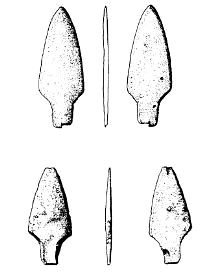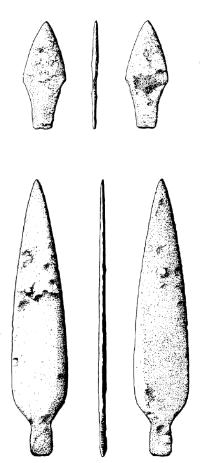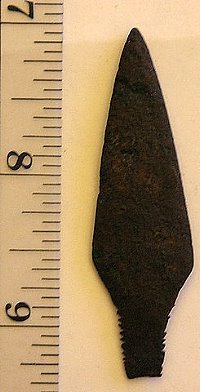Metal Projectiles in Medina County: Signs of Change
For archeologists, metal objects are a clear indicator that they are looking at cultural remains of the Historic period, that is, items made after Anglo-Europeans began arriving in North America. Although quantities of metal projectile points were made by European and American manufacturers for trade with the Indians, many points were made by the native people themselves. In Spanish missions, the mission Indians (neophytes) were taught the skills of blacksmithing. This required them to learn how to work with new materials, such as metal barrel hoops instead of stone cores, and to use new tools, such as files and metal chisels, instead of antler batons and hammerstones for chipping flint. Metal was often in short supply on the frontier, however. Even as they mastered new metal-working techniques, native peoples continued making chipped-stone points.
Metal points of diverse shapes and sizes have been found all across the South Texas Plains. Here we look at just a few representative examples. The metal projectile points shown in the drawings at right —three iron arrow points and one spear or lance point—are from privately held surface collections in Medina County, documented by dedicated South Texas avocational archeologist C. K. Chandler.The photograph at bottom is a metal projectile found farther south, in La Salle County.
Though such finds are rarely reported, it is not surprising that these items would be found in this region. South Texas was criss-crossed by trails from Mexico to San Antonio and beyond, used by Native Peoples and early Spanish explorers alike. Roads followed these trails, including the Old San Antonio Road and Camino de los Tejas. Farther to the south another major route extended from Laredo to San Antonio, passing through La Salle County and crossing the Frio River just west of Tilden. Two other routes, both called the Camino Real, went from Goliad to Mission San Juan Bautista and Laredo. Comanche hunting and raiding trails leading from the north into Mexico also crossed the area.
With the exception of metal points from Spanish Mission sites and several others, the few points that have been reported were almost invariably found on the surface. Some were found with sherds of bone-tempered pottery and late-period chipped-stone arrow points, including Perdiz, typically considered hallmarks of the late part of the Late Prehistoric period. Archeologists have not determined whether these objects represent a coherent “toolkit” or rather a mix of objects discarded at the same spot by different peoples at different times.
Sources
Brown, Kenneth M. and A. J. Taylor
1989 A Comment on Metal Arrow Points. La Tierra 16(4):
10-22..
Chandler, C. K.
1993 Metal projectile Points from Medina County, Texas. La Tierra 20(4):
29-32. Download and read pdf.


